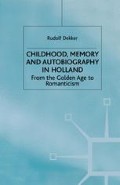Abstract
Today, play is considered an important part of a child’s life. It seems therefore strange that Constantijn Huygens in his diary made only one reference to the subject, expressing his aversion when little Lodewijk played at being a soldier. Elsewhere he remarks in passing that he is glad his children would rather learn than play. Huygens is no exception. His contemporary, Dirck Jansz, wrote that his little son should put aside his games for more virtuous work. Silence and occasional negative remarks about play are typical in egodocuments of this period. English and American parents similarly rarely wrote about the games their children played.1 In the nineteenth century, the diarist, Willem de Clercq, is the first parent to mention his children’s games and toys with enthusiasm. This indicates a new attitude.
Access this chapter
Tax calculation will be finalised at checkout
Purchases are for personal use only
Preview
Unable to display preview. Download preview PDF.
Notes
Lodewijk van Deyssel, Gedenkschriften, Harry G.M. Prick (ed.), 2 vols (Zwolle: Tjeenk Willink, 1962; first edn 1924) pp. 89–93.
Theo Thijssen, In de ochtend van het leven. Jeugdherinneringen (Bussum: Agathon, 1974; first edn 1941) pp. 86–111.
Johanna Drost, Het Nederlandsch kinderspel voor de zeventiende eeuw (Den Haag: Martinus Nijhoff, 1914) p. xviii.
Petrus Nicolaas Maria Bot, Humanisme en onderwijs in Nederland (Utrecht/Antwerpen: Het Spectrum, 1955) p. 63, note 4; Goede manierlijcke zeden (Antwerpen: Steven Mierdmans, 1546);
cf. J. van Vloten, ‘Levensmanieren naar een handleiding der 16e eeuw’, Dietsche Warande 6 (1864) pp. 337–61, p. 350. The Latin edition was published in 1530. Cf. Simon Willem Bijl, Erasmus in het Nederlands tot 1617 (Nieuwkoop: De Graaf, 1978) pp. 187–97; Het boeckje van Erasmus aengaende de beleeftheidt der kinderlijcke zeden (Amsterdam: Servaas Wittelingh, 1678); repr. H. de la Fontaine Verwey (ed.) (Sint Anna ter Muiden, 1967).
Dirck Hals, ‘Kinderen bij het kaartspel’ (1631), in Judith Leyster. Schilderes in een mannenwereld (Zwolle: Waanders, 1993) nr. 26.
Gary Schwartz and Marten Jan Bok, Pieter Saenredam. The painter and His Time (Den Haag: Gary Schwartz/SDU, 1990) p. 200.
Cf. Kathrin Joppien-Hauck, Das Kind und sein Spielzeug. Ein Motiv der europäischen Kunst seit der Pädagogik der Aufklärung (Bonn: Rheinische Friedrich-Wilhelms-Universität, 1988).
John Locke, Some Thoughts Concerning Education John W. and Jean S. Bolton (eds) (Oxford: Clarendon Press, 1989) p. 191.
Karin Calvert, Children in the House. The Material Culture of Early Childhood, 1600–1900 (Boston: Northeastern University Press, 1992);
Brian Sutton-Smith, Toys as Culture (New York/London: Gardner Press, 1986). Annemarieke Willemsen, ‘Overal afblijven, de materièle cultuur van het kind’, in Kinderen van alle tijden, pp. 31–53.
F.A. Hartsen, Nederlandsche toestanden. Vit het leven van een lijder, Nop Maas (ed.) (Hilversum: Verloren, 1996; first ed 1870).
H.B. Schwartzman, Transformations, the Anthropology of Children’s Play (New York/London: Plenum Press, 1978).
Cf. Mahadev L. Apte, Humour and Laughter. An Anthropological Approach (Ithaca/London: Cornell University Press, 1985) pp. 87–92.
Hildebrand, Camera obscura, p. 29; Cf. Nicolaas Beets, De grote jongen. De psychologie van de jongen in de vlegeljaren (Utrecht: J. Bijleveld, 1964) pp. 56–8.
M.D. Teenstra, De kinderwereld (Groningen: J. Oomkes, 1853).
Author information
Authors and Affiliations
Copyright information
© 2000 Uitgeverij Wereldbibliotheek BV
About this chapter
Cite this chapter
Dekker, R. (2000). Children’s Play. In: Childhood, Memory and Autobiography in Holland. Early Modern History: Society and Culture. Palgrave Macmillan, London. https://doi.org/10.1007/978-1-349-62377-8_9
Download citation
DOI: https://doi.org/10.1007/978-1-349-62377-8_9
Publisher Name: Palgrave Macmillan, London
Print ISBN: 978-1-349-62379-2
Online ISBN: 978-1-349-62377-8
eBook Packages: Palgrave History CollectionHistory (R0)

